Special Purpose Cartridges
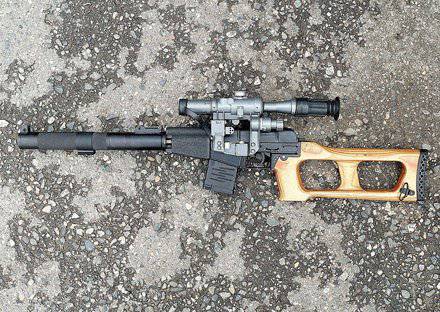
Strengthening the confrontation between the Soviet Union and the West in the 1950 – 1980-s of the last century, expanding the geography of undeclared wars and local military conflicts that were fought on almost all continents, required for this struggle more and more new types of special weapons, including fighting at short distances with enemy manpower, equipped with personal protective equipment.
The result of this confrontation was the creation for the KGB of the USSR and special-purpose units and subunits of the Main Intelligence Directorate of the General Staff of the Soviet Army special complexes “ammunition - small weapon", Designed to conduct silent shooting and shooting in the aquatic environment.
Special-purpose cartridges are, perhaps, one of the most diverse in types and types of ammunition category of cartridges used not only in samples of special small arms, but also in various shooting devices intended for use in special conditions. These munitions differ in design and size from those adopted for ordinary small arms and, as a rule, do not fit them, but they may contain individual elements of regular ammunition. As a missile body in these cartridges can be used as bullets of various, even the most unusual design, and liquid or gaseous substances, causing a goal or a fatal injury, or shock effect. As a rule, such ammunition is supplied to the armament of a number of units of the Armed Forces and special services in a very limited number, and sometimes in single copies.
The specifics of conducting covert operations by units and special-purpose units (reconnaissance operations; raids to the rear of the enemy; the elimination of a particular object) depends largely on the suddenness of the operation and the maximum disguise of the shooter. However, the use of firearms for these purposes is not always convenient, since the sound and the flame of a shot often give an arrow and lead to the most negative consequences. Therefore, the noiselessness of the shot has always been one of the requirements for special weapons.
They tried to solve this problem in different ways. And only from the end of the XIX century, with the creation of silent flameless firing devices (or so-called silencers), designed to equip small arms, a palliative solution was found to this issue. At the same time, it must be immediately emphasized that no muffler can completely muffle the noise from the shot. But he can significantly reduce the noise and unmasking flash shots. The design of the silencers uses two main factors to silence the sound:
1. The cause of the sound of a shot is a shock wave arising from the rapid expansion of powder gases after their release from the barrel bore behind the bullet. The main stream of powder gases rushes after the bullet under high pressure and temperature with a speed exceeding several times the speed of the bullet. At this moment, the air surrounding the bullet is sharply compressed, forming a powerful air wave - it creates the sound of a shot (with a noise level up to 130 decibels).
2. The second reason for the sound of a shot is a ballistic wave, formed as a result of a meeting of a bullet with an air medium and acting with a high-frequency sound. The sound from the ballistic wave becomes smaller as the speed of the bullet decreases and disappears altogether as soon as the speed of the bullet falls below the speed of sound in the air (at 0 ° C - 330 m / s). Therefore, the problem of eliminating this sound is solved quite simply - by reducing the speed of the bullet to subsonic.
Our country is no exception to the rule. Weapons with silencers appeared in the Soviet Union already in the middle of the 1930-s and were effectively used during the Great Patriotic War. Designing weapons for silent and flameless firing required the preliminary development of the basic principles of silencing a shot and the development of a theoretical and practical basis for the study of the most rational parameters of the silencer (nozzle), expansion chamber, and the design of the gun as a whole. This task in the 1960-s was successfully solved by the specialists of the Scientific Research Institute-61, later known as the Central Research Institute of Precision Engineering (TsNIITOCHMASH) in Klimovsk, Moscow Region. It was with the advent of new technologies developed by these designers that such weapons took their present place in the special forces weapons system.
In the 1950 – 1960-s, a number of secret weapons were developed for arming special purpose units and subunits of the Soviet Armed Forces and state security agencies of the USSR for silently flameless fire. Structurally, they can be divided into three groups:
1. These weapons, designed for arming units and units of military intelligence and special forces of the GRU GSh, are an individual means of covert attack and defense and are intended for hitting targets with aimed fire under conditions that require silent, flameless shooting at the enemy’s open manpower (destruction of enemy command personnel ; his reconnaissance groups; observers and sentries), as well as the decommissioning of instruments. In this weapon, as a rule, regular or special ammunition equipped with bullets with a reduced initial speed are used). However, since it is impossible to change anything in this weapon, since the dimensions of the weapon are rigidly tied to the physical basis of the shot process, then to solve the problem of a silent shot with small dimensions of the weapon itself, fundamentally different theoretical and design approaches were required.
2. The second group of domestic short-barreled weapons for the KGB and the GRU, intended for silent firing, no longer include individual samples, but entire “ammunition-weapon” complexes created for special silent ammunition.
3. The third group of special ammunition consists of underwater “ammunition-weapon” complexes - pistol and automatic, based on the active principle of bullet throwing.
Cartridges for weapons with devices for silent and flameless shooting
7,62 x 54 R CSS Along with the Red Army 7,62-mm Mosin shop rifle arr. 1891 / 30 widely used and the state security agencies, and taking into account their specifics. In the middle of the 1930-ies, the designers of the special laboratory, brothers V.G. and I.G. Mitina, developed several types of silencers with expansion-type chambers to equip a Mosin rifle mod. 1891 / 30's. In 1938, the Red Army and NKVD bodies adopted a new set of special small arms equipped with silent flameless firing devices, known by a common index by the name of the inventors - BRAMIT. These devices were used for firing from regular weapons - rifles mod. 1891 / 1930's and the DP machine gun. Two rubber seals 15 mm in thickness in two cameras of the BRAHAM device were designed for several dozen shots. For firing Mosin rifles, equipped with devices for silently flameless shooting BRAHMIT, special 7,62-mm US rifle cartridges (reduced speed) with a reduced powder charge and a light bullet were used. Powder charge - BT brand (0,45 gram weight) was chosen in this way so that the initial speed of the bullet was subsonic and was no more than 260 m / s. This, in conjunction with the device for silently flameless shooting, ensured the jamming of the sound of the shot. To distinguish the cartridge with a reduced speed of a bullet designed for rifles mod. 1891 / 1930's, the whole bullet and the bottom of the cartridge case were painted with green lacquer, and the cartridge intended for firing from the DP machine gun was also completely painted with black lacquer.
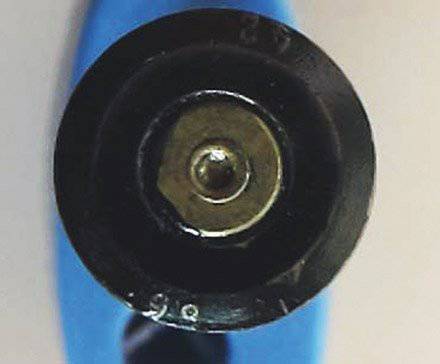
7,62 x 39 FF. In 1956, a special Kalashnikov AK assault rifle, equipped with a device for soundless and flameless firing of the expansion type with partial gas cut-off (PBS) of the engineer I. I. 61, LI Golubev, comes into service with reconnaissance and sabotage units and special purpose units. In the CBE device and its modification of the PBN-1 (1962 g.), Sound jamming was achieved not only by reducing the pressure of the powder gases at the muzzle, but also by using new cartridges with subsonic bullet speed. Shooting from this silencer of the sound of the shot was conducted with special 7,62-mm automatic cartridges of US mod. 1943 of the year (57-H-231 U index) with a reduced (to 270 – 295 m / s) bullet speed created by the GM-61 research institute G. M. Tereshin and K. V. Smekayev under the supervision of the head of the munitions department B. V. Semina. The increase in the mass of the bullet to 12,5 g in order to save energy was achieved by increasing its length to 33,62 mm (the length of the bullet of the cartridge with a steel core - 26,8 mm). US bullet - pointed, without a back cone with a groove, has a composite core - steel hardened - head and lead - the main one. The required penetrative action was achieved using a U12 A tool steel core located at the head of the bullet. The lead core, located behind it, not only created the necessary mass, but also served as a shirt. The selected diameter of the 7,94 mm bullet (for all other bullets, the diameter is 7,92 mm) ensured the bullet penetration into the grooves and the required pressure of the powder gases in the barrel. A bullet having a subsonic initial velocity did not create a ballistic wave on the trajectory, and the silencer PBS reduced the flow rate of gases from the muzzle of the barrel. The propellant charge is pyroxylin powder P-45, weight 0,57, the US bullet pierced a steel helmet at a distance of up to 400 m and an anti-splinter vest at a distance of 75. The bullet color is a black tip with a green belt. The cartridge US was produced with bimetallic or steel lacquered sleeves. The metal box with cartridges fit 3 obturator, each of which was designed for 200 shots.
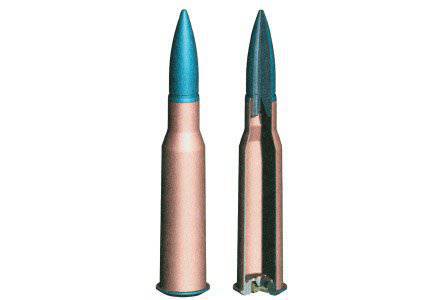
5,45 x39 FF. At the beginning of the 1980-s for silent single-shot firing of shortened Kalashnikov assault rifles AKS 74 UB, equipped with an AS Negodova PBS-4 device (with partial gas cut-off), TI NIITOCHMASH engineers (work manager) and V. A. Nikolaev was developed for silent and flameless shooting of an 5,45-mm assault rifle with a US bullet (index 7 У1). The initial speed of the bullet of this cartridge was 303 m / s, i.e. it was subsonic. To partially compensate for the sharply reduced energy and the damaging effects of the bullet, the mass of the bullet had to be increased to 5,15. The US bullet was pointed, without a back cone and a groove, with a ledge toward the elongated head part, in which a heat-strengthened arrow-shaped core was placed in a lead shirt . The propellant charge is spheroid powder SF033, weight 0,57 g. The distinctive color of the US cartridge bullet is the black tip of the bullet with a green belt.
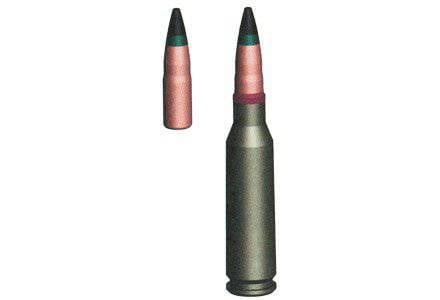
9 x39 – 9-mm special cartridges with subsonic bullet speed: sniper joint venture. 5 (index 7 Н8) and armor-piercing joint venture. 6 (index 7 Н9) for low-noise firing from BCC rifles (Vintorez), VSK-94, machine guns АС ("Shaft"), СР.3 ("Whirlwind"), 9 А91.
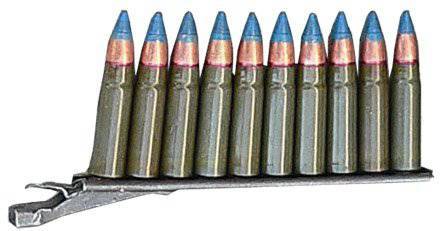
At the end of the 1970s, the requirements for designing a special silent weapon complex for a new assault rifle cartridge were worked out on the order of the leadership of the KGB of the USSR and the GRU of the Soviet Army. In TsNIITOCHMASH, designers P. I. Serdyukov and V. F. Krasnikov set about creating a new complex that received the RG-O36 index and special cartridges. The design of this complex began with the creation of a new assault rifle cartridge, designed to destroy enemy personnel in specific conditions.
In the new weapon two incompatible properties should be combined - the increased penetration capacity of the bullet while reducing the sound level of the shot. Moreover, the shot killing could only be achieved with the use of silencers and subsonic initial speed. Soon, designer N. V. Zabelin and technologist L. S. Dvoryaninova created an 7,62-mm RG-037 automaton cartridge with a reduced initial bullet velocity (based on the 5,45 x39 cartridge case), but was modified according to the 7 H1 cartridge bullet, but modified with taking into account the requirements of external ballistics for bullets with subsonic flight speed. The total length of the cartridge was 46 mm, the mass - 16 g, the mass of the bullet - 10,6 g, the median deviation (R50) at a distance of 100 m was 4 cm, and at a distance of 400 m - 16,5 see. However, this cartridge did not allow to confidently hit the enemy's strength in the fragmentation armor at the 400 direct shot range, m. Therefore, TsNIITOCHMASH designers, N. V. Zabelin, L. Dvoryaninova, and Yu. Z. Frolov, design a new 7,62-mm sniper cartridge on the basis of the 9-mm cartridge sleeve. 5 with a heavy bullet 7 H8 mass 16,2 g (with subsonic initial speed - 295 m / s).
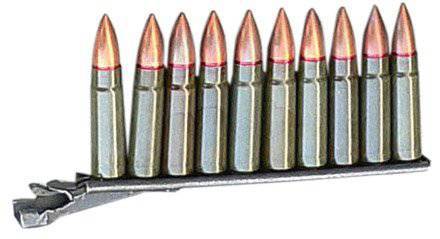
Patron sp. 5 possessed the energy that enabled them to hit manpower in personal protective equipment. The subsonic initial speed of the bullet of this cartridge provided the necessary sound reduction when using a silencer, and the increased mass of a bullet with a steel core (possessing considerable kinetic energy - when departing it was around 60 kgm, and at a distance of 450 m - 45 kgm) - sufficient penetration distances to 400 m. Mass of the cartridge SP. 5 – 32,2 g, cartridge length - 56 mm. The 7 H8 bullet is a pointed octopus, with a bimetallic sheath, with a rear cone and a groove, and has a composite core: a steel head (with a truncated top) and a basic lead one. A steel core to enhance the bullet penetration was placed in its nose section. The edges of the bimetallic shell are not rolled up and form a cavity with a depth of 2 mm. The shape of the bullet length 36 mm provided her with good ballistic properties when flying at subsonic speeds. Bullet weight 16,0 g, core - 3,25 g. Cartridges JV. 5 are equipped with powder brand P-45 (weight 0,6 g). Lacquered steel liners are not marked. Also 7 H8 bullets cartridges of the joint venture. 5 do not have a distinctive color. Only on the carton carton on the 10 cartridges is the inscription "Sniper".
In 1987, a new model of weapons, created on the basis of RG-036 and known under the conditional name "Vintorez", was adopted by the special forces of the KGB of the USSR and reconnaissance and sabotage units of the Soviet Armed Forces, as well as special-purpose units of the Interior Ministry forces under the designation "rifle sniper special (BCC) "(index 6 ПХNUMX) and" 29-mm special cartridge SP. 9.
Patron sp. 5 H7 8 heavy-bullet steel core bullet providing 100% penetration of 6-mm special steel sheet at the 100 m firing range and 400-mm steel sheet at 2 m, while maintaining sufficient slaughter overheading action received the most flattering reviews from experts. Its use in the BCC rifle made it possible to defeat enemy personnel even at the ultimate range of aimed fire, and at 100 m distance - in body armor to class II protection inclusive (according to modern classification), which put it on par with the most formidable types of infantry small arms .
At the same time, P. I. Serdyukov, on the Shaft theme, developed another set of silent weapons on the basis of the VSS rifle, including: a special AS machine gun, which is an upgraded version of the Vintorez and a more powerful 9-mm cartridge SP. 6 with an armor piercing bullet for this weapon, which was created by engineers Yu. Z. Frolov and E. S. Kornilov. Bullet cartridge sp. 6 consisted of a steel core, a lead shirt and a bimetallic sheath. Due to its design, the bullet cartridge SP. 6 had a higher punching effect than the bullet of the SP cartridge. 5. The 7 H9 bullet had a bimetal sheath with a rear cone and a sharp-pointed steel heat-strengthened core (6,5 mm diameter) protruding into a lead shirt on the 7,5 mm. The steel core of this bullet was significantly longer than that of the SP cartridge bullet. 5. The length of the leading part of the 7 H9 bullet was reduced to 10 mm ledge, which forms a cylindrical centering area (diameter 9 mm and length 6 mm), so the nose of the bullet protruded from the shell. The core has an ogival head and a back cone. The mass of the bullet is 15,6 g, the core is 10,4 g, with the mass of the cartridge is 32,0 g. The length of the cartridge is 56 mm, the length of the bullet 41 mm. Top of 7 H9 bullet cartridge SP. 6 was painted black. A distinctive black strip was applied to the cartoning cartons for these cartridges. Later, after the appearance of 9-mm automaton cartridges with an 7 H12 armor-piercing bullet, the tip of the bullet of the cartridge SP. 6 began to turn blue.
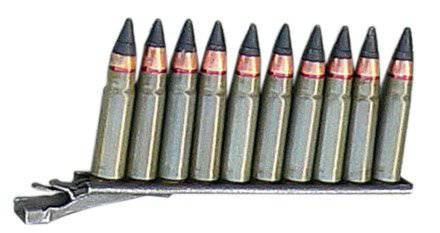
Patron sp. 6 was designed to defeat manpower protected by splinter vest up to class III protection inclusive (according to the modern classification) or 5-mm steel plates, as well as unarmored equipment at a distance of 400 m, which is equivalent to the penetration of the American 5,56 A16 American rifle M1 A7,62 , 5,45 mm AKM and 74 mm AK XNUMX.
According to ballistics bullets SPN5 and JV. 6 are similar, so they can be used in weapons with the same sights. But the accuracy of bullets 7 H8 cartridges SP. 5 is slightly better than that of the half-shell 7 H9 bullets of SP cartridges. 6. The device and the characteristics of the bullets determined the purpose of these munitions:
- cartridge SP. 5 is used for sniper shooting at uncovered manpower,
- cartridge SP. 6 - for hitting targets in personal protective equipment or being in vehicles or behind other lightweight shelters.
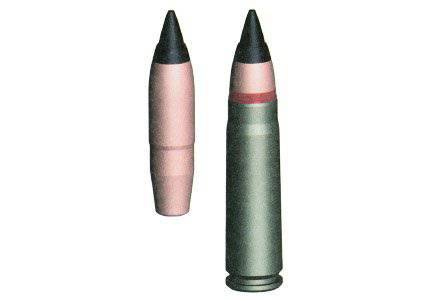
Cartridges JV. 5 and SP. The 6 for the BCC rifle and the AU machine gun are also interchangeable, and in addition to that, in the AU machine gun it is possible to use their cheaper version - the PAB-9 cartridge. Cartridges JV. 5 and SP. 6 produced Klimovskom specialized stamping (cartridge) plant.
The developers of the new weapon wrote: “The 9-mm cartridge, which has a unique penetrating and damaging effect, will reach your enemy wherever your eyesight will reach it, simultaneously punching any body armor from those that a real person can wear without help. And a not too long lineup can do enough damage to damage a truck, launcher, or radar. ”
In addition to this weapon, several new types of special forces weapons appeared in the same years. The most original compact models of domestic-made automatic weapons include the unique 9-mm small-sized Vortex CP-3 submachine gun, as well as its competitor, the 9-А9 91 automat.
The use of 9-mm automaton cartridges JV. 5 / SP. 6, as well as their more simple and cheap version of the PUB.9 allowed to achieve "Whirlwind" excellent performance. So, when firing an armor piercing cartridge JV. 6 at a distance of 100 m is provided by 100% penetration of body armor with two titanium plates 1,4 mm thick and 30 Kevlar / TCBM layers or steel sheet 6 mm thick with preservation of supergradual slaughter effect.
At the end of 1980-ies, while Klimov gunsmiths were working on the CP-3 “Whirlwind” small-sized machine gun, Tula gunsmiths from the Design Bureau of Instrument-Making Industry (KBP) began to work on an alternative option to him — the 9 А91 machine gun. In 1994, the 9 A91 assault rifle adopts the internal troops and the Ministry of Internal Affairs to solve a number of specific tasks.
Since the 9 A91 machine gun went into service with the internal affairs bodies of the Russian Federation, the leadership of the Ministry of Internal Affairs had to attend to another problem - the supply of these weapons with ammunition. Since special 9-mm automaton cartridges JV. 5 and SP. 6, because of the special types of steel and metals used in them, turned out to be extremely expensive, for supplying mass weapons, which became the 9 А91 submachine guns after they were armed with a significant number of subdivisions of the internal affairs agencies, it was necessary to create cheaper ammunition. In the middle of 1990-ies such 9-mm cartridge automatic armor-piercing PAB.9 (cheaper cartridge than SP 6) for firing from the 9 A91 and the VSK-94 rifle using a bullet with a reinforced steel core was created by specialists from the Tula cartridge . Shooting cartridges PAB.9 of the BCC and the AU was not provided. This allowed to satisfy all the needs of the police in these cartridges. Bullet PUB.9, unlike the joint venture. 6, had a truncated tip core protruding on 8,2 mm, with a shoulder and a cylindrical part of 07,0 mm. At the same time, the length of the leading part was increased by 3,5 mm, and the centering length was reduced by 4,5 mm. Forcing pressure (due to the greater length of the leading part) and the initial speed of the bullet PUB.9 compared to the joint venture. 6 is higher, but the accuracy is lower. The bullet of the PAB.9 cartridge provides for the defeat of the enemy's manpower in individual class III means of protection, and at a distance of up to 100 m is guaranteed to penetrate an 8-mm steel sheet. Externally, the PAB.9 cartridges are different from the SP cartridges. The 6 is a truncated tip of the protruding core of the bullet and the presence of a mark that includes the inscription "9 x39 TPZ" and two digits of the year of manufacture. Bullet weight - 17,2 g, core - 9,9 g, gunfire brand PSI - 0,65 g. After the delivery of several batches to the internal troops of the Ministry of Internal Affairs of the Russian Federation, the use of cartridges PAB.9 was prohibited.
Therefore, the 9-mm assault rifle cartridge with an armor-piercing bullet (index 9 Н7) was developed to replace the PUB.12 Tula cartridge plant. In the course of tests conducted by the State Commission of the Grau Ministry of Defense of the Russian Federation in June 2003, the new cartridge showed an increase in armor penetration by 10% and accuracy by 25%. The bullet of the cartridge is structurally similar to the joint venture pool. 6, but the shape of the truncated vertex is preserved. Externally, the 7 ПХNUMX cartridge differs from PUB.12 only in its stamp, which includes the plant number and the last two digits of the year of manufacture. The mass of the bullet 9 g, the core –15,7 g., The powder “П-10,45” - 45 g.
Information